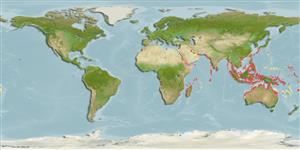Common names from other countries
>
Gobiiformes (Gobies) >
Gobiidae (Gobies) > Gobiinae
Etymology: Glossogobius: Greek, glossa = tongue + Latin, gobius = gudgeon (Ref. 45335).
More on author: Hamilton.
Environment: milieu / climate zone / depth range / distribution range
Ökologie
seewasser; süßwasser; brackwasser benthopelagisch; amphidrom (Ref. 51243); tiefenbereich 0 - 5 m (Ref. 86942). Tropical; 25°C - ? (Ref. 2059); 30°N - 32°S, 25°E - 176°E
Africa to Oceania: Red Sea and East Africa, south to Transkei in South Africa, and most inland freshwater bodies over the Indian Ocean and western Pacific (Ref. 4343, 52193). Common in coastal and estuarine waters from austral Africa and Madagascar to India and south of China.
Length at first maturity / Size / Gewicht / Alter
Maturity: Lm ?, range 9 - ? cm
Max length : 50.0 cm SL Männchen/unbestimmt; (Ref. 4967); common length : 11.3 cm SL Männchen/unbestimmt; (Ref. 35840)
Rückenflossenstacheln (insgesamt): 7; Rückenflossenweichstrahlen (insgesamt): 8-9; Afterflossenstacheln 1; Afterflossenweichstrahlen: 8 - 9.
Found mainly in freshwater and estuaries, but also enter the sea (Ref. 4833). Also occur in canals, ditches and ponds (Ref. 12693). Found in clear to turbid streams with rock, gravel or sand bottoms (Ref. 2847). Encountered in medium to large-sized rivers of the lower Mekong (Ref. 12975). Feed on small insects, crustaceans and small fish. Grow to a much larger size in brackish water than in fresh water. Marketed fresh (Ref. 12693). Cannibalism is relatively common for this species (Ref. 48660).
Spawning occurs in freshwater afterwhich eggs and larvae are washed down by the river current into the sea (Ref. 110258).
Maugé, L.A., 1986. Gobiidae. p. 358-388. In J. Daget, J.-P. Gosse and D.F.E. Thys van den Audenaerde (eds.) Check-list of the freshwater fishes of Africa (CLOFFA). ISNB, Brussels; MRAC, Tervuren; and ORSTOM, Paris. Vol. 2. (Ref. 4343)
IUCN Rote Liste Status (Ref. 130435)
CITES (Ref. 128078)
Not Evaluated
Bedrohung für Menschen
Harmless
Nutzung durch Menschen
Fischereien: weniger kommerziell; Aquakultur: kommerziell; Aquarium: Kommerziell
Tools
Zusatzinformationen
Download XML
Internet Quellen
Estimates based on models
Preferred temperature (Ref.
115969): 25 - 29.3, mean 28.5 (based on 2836 cells).
Phylogenetic diversity index (Ref.
82804): PD
50 = 0.5000 [Uniqueness, from 0.5 = low to 2.0 = high].
Bayesian length-weight: a=0.00724 (0.00642 - 0.00818), b=3.07 (3.04 - 3.10), in cm Total Length, based on LWR estimates for this species (Ref.
93245).
Trophic level (Ref.
69278): 3.7 ±0.2 se; based on diet studies.
Widerstandsfähigkeit (Ref.
120179): hoch, Verdopplung der Population dauert weniger als 15 Monate. (K=0.8; Fec=18,578;).
Fishing Vulnerability (Ref.
59153): Low to moderate vulnerability (26 of 100).
